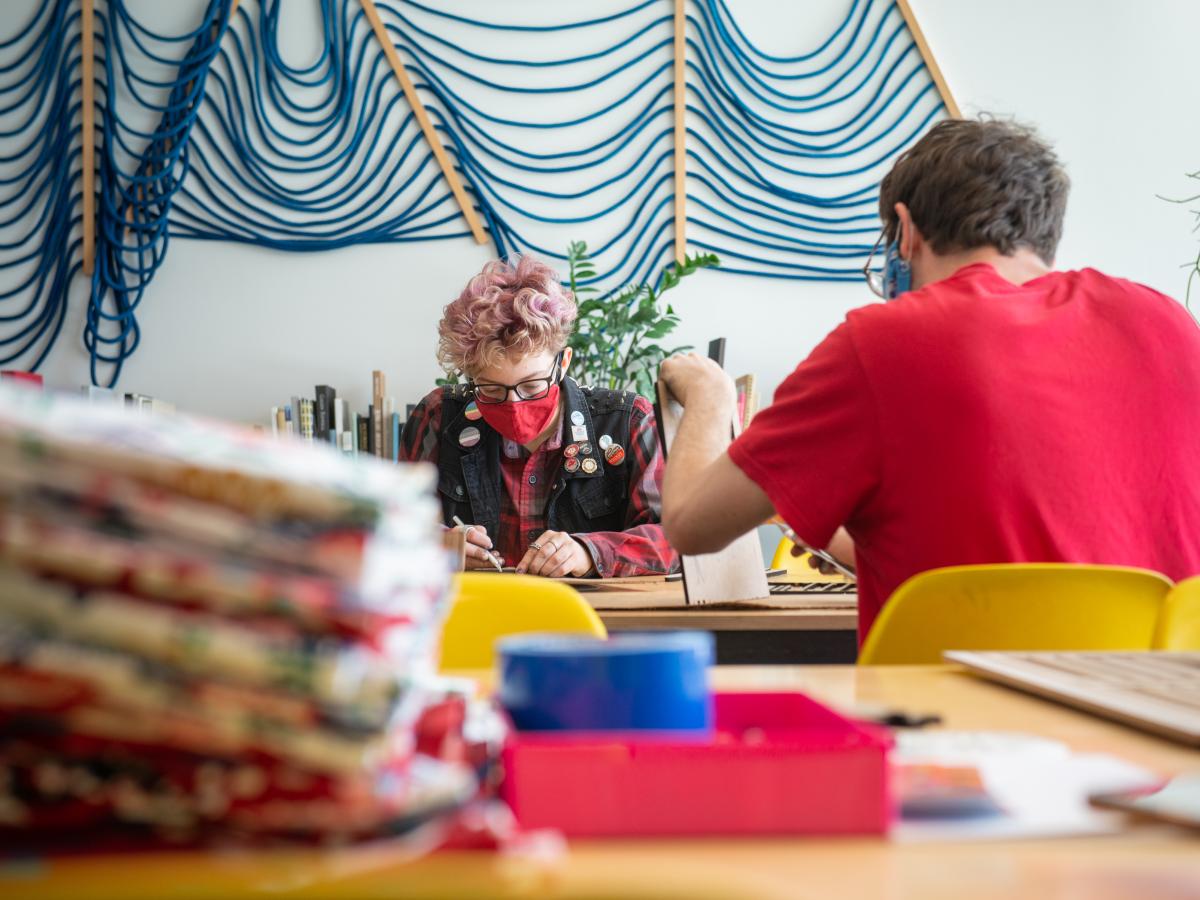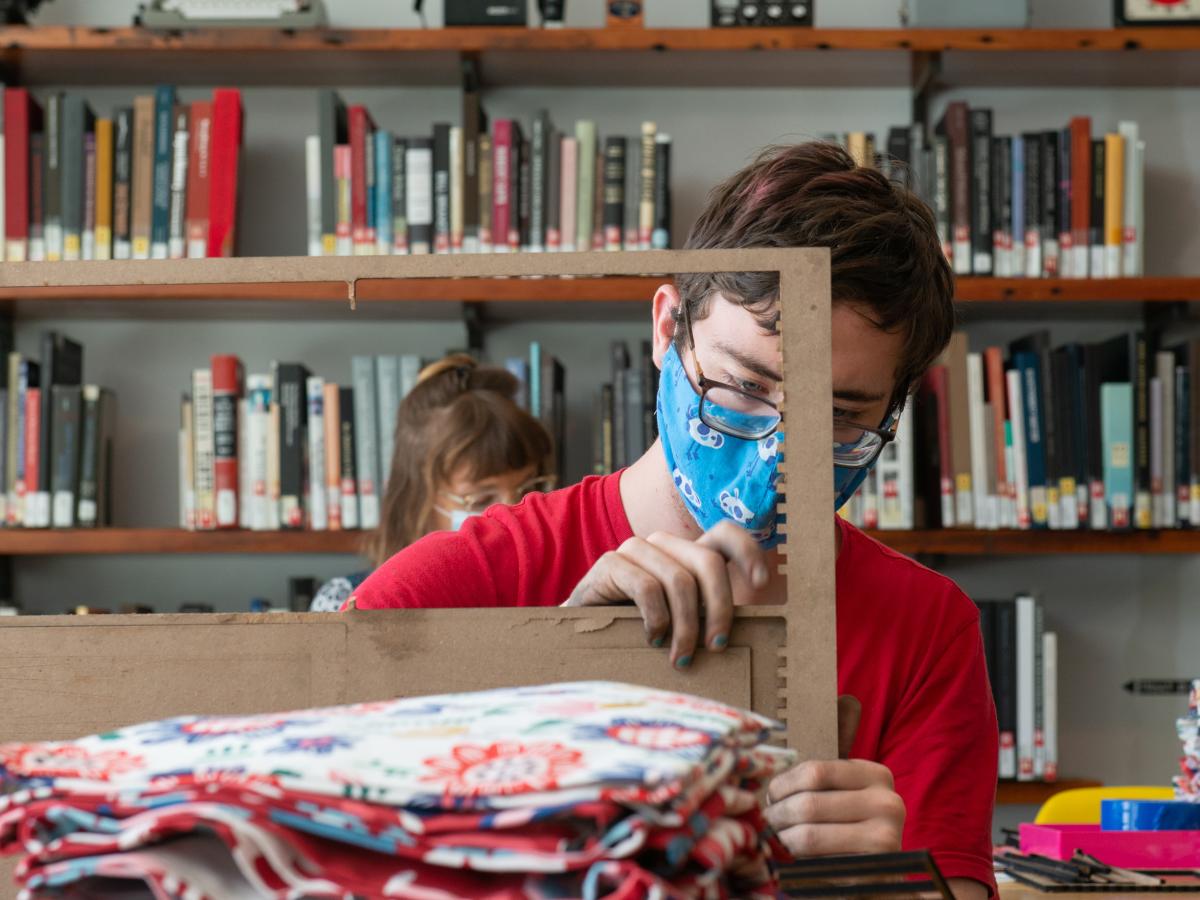May 4, 2021
When the COVID-19 pandemic first hit, Raquel Dunoff, an Engineering Major with a Concentration in Experience Design graduating Fall 2021, picked up weaving and found that this tangible art form was cathartic in a world that felt especially changeable and out of control.
Dunoff further pursued her interest in weaving by taking Weaving the Future: New Ideologies of Making, a Fall 2020 elective taught by Arlene Keizer, Olin’s third Sketch Model Creative-in-Reference.
In Weaving the Future, Professor Keizer led students through “examinations of the ideologies of making behind consumer products, popular film, literature, and visual culture, using texts by artists, designers, philosophers, cultural critics and creative writers.” During the semester, students built on past engineering or craft projects and wove new objects designed to represent an ideology of importance to them such as sustainability, salvage, or interconnectedness. More than two dozen students signed up for the course and each received a small tabletop loom to use for the entirety of the course. For their final project, Art and Craft as Response and Refuge, several students designed their own looms and wove with various fibers. For her part, Dunoff designed a circular shaped loom out of a Frosted Honey Bunches of Oats cereal box and created a weaving with yarn to represent the shape and coloring of light shining through a tree with Autumn leaves. While working with Olin engineers, Keizer said she was “surprised and delighted by the students’ willingness to engage with the literature and critical theory I assigned. Though many of the ideas were new to most of the students, they were able to begin to incorporate these (sometimes) esoteric concepts into their engineering knowledge.”

Two students work on weaving in the Library's Quiet Room during the Community Weaving Workshop. Photo by Leise Jones.
In addition to her role teaching Weaving the Future, Keizer also curated a speaker series, Weaving and/as Technology, Theory, and History highlighting “weavers who use advanced computer technologies and play with the relationship between the handmade and the computer-generated.” Keizer developed her residency at Olin around the idea of ideologies of making.
“I use this term to describe the set of principles and values by which decisions about design, fabrication, and use are made. These often-unspoken ideas and values establish the conditions of possibility for making within a culture. Ideologies of making determine how designers and engineers within any given cultural system will set priorities for imagining and crafting objects and processes,” said Keizer.
Speakers over the course of the academic year included Laura Devendorf, Assistant Professor at the University of Colorado, Boulder and Director of the Unstable Design Lab and Sarah Rosalena Brady, Assistant Professor of Art at UC Santa Barbara in Computational Craft and Haptic Media and affiliated faculty at the Center for Responsible Machine Learning.
After the class ended, Dunoff wanted to share the meditative process of weaving with others and to help connect the Olin Community. Dunoff described herself as being in “a mindset that valued the tangibility of mail,” especially while people might not physically be able to be together. Conversations about creating a weaving kit that could be distributed to participants and used in a community event had been ongoing between Professor Keizer, Callan Bignoli, Director of the Olin Library and McKenzie Mullen, Community Engagement Librarian. In collaboration with Keizer and the Olin librarians, Dunoff surveyed the Olin Community to find out who might be interested in a virtual Community Weaving Workshop and set out to design a loom and accessories that could be sent out to participants in the mail.
Dunoff first designed a loom out of cardboard at home where she had been working remotely since the start of the pandemic. She then designed the loom in Adobe Illustrator and sent it to the Olin Shop where the prototype was refined. Copies of the loom cut from plywood were sent off to a small group for testing. The testing group included Kristin Casasanto, Program Director for External Engagement, Nate Cantrell, Instructor of Welding and Fabrication, Ben Linder, Professor of Design and Mechanical Engineering and McKenzie Mullen. In addition to being part of the testing group, Mullen also ran a virtual weaving workshop event with over 30 people attending virtually along with a group of socially distanced participants in the library.
Testers provided valuable feedback including recommending changing the material of the loom from plywood which was splintering to a eucalyptus board material. Dunoff also received suggestions for other tools that would be a good addition to the weaving kits including a comb used for packing material in place while weaving, needles and a shuttle used to carry the crosswise threads (weft) through lengthwise threads (warp). The final design wasted very little material as the loom and accompanying tools were cut out of the same template and four weaving kits fit on each sheet of eucalyptus board.

A student works with a loom in the Library during the Fall 2021 Workshop. Photo by Leise Jones.
This process was not without its challenges as not only were the looms produced in large quantities or “at scale” which is uncommon for the small population at Olin, but Dunoff had to learn how to oversee a project that sought to produce a physical thing that she was largely unable to physically touch. “It was frustrating not being able to be on campus to do things that used to be so simple, like walking a laser cut loom from the Shop in the AC to the Library in MH for assembly or shipping,” said Dunoff.
Once the final design was established it was sent to Makerstock to be manufactured at scale. Following production at Makerstock, the 50 final laser cut looms (45 for workshop attendees and 5 for the organizers) were shipped to Olin where Library staff and student workers carefully punched out all 500 pieces of the kits from the eucalyptus boards, put them into hand sewn pouches made by Keizer and shipped them out to Oliners around the globe.